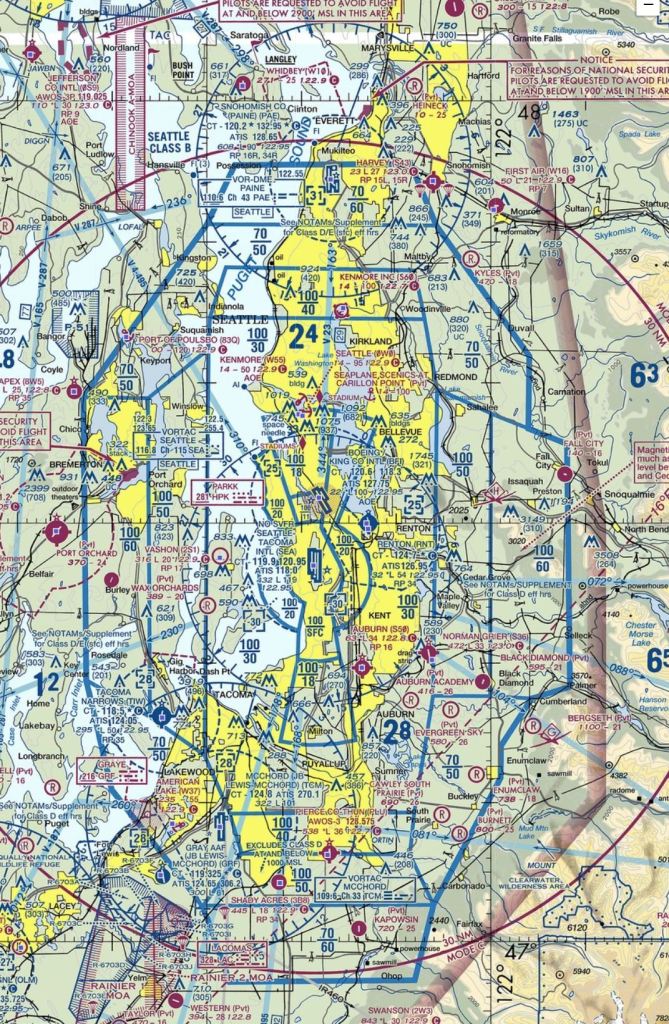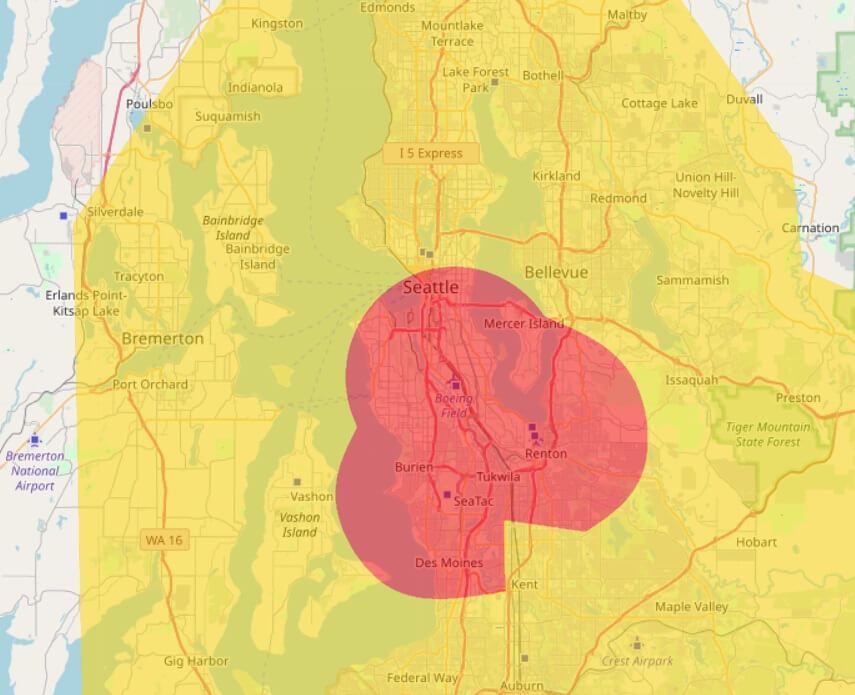
Where can you fly a drone in Seattle Washington?
In Seattle you may fly your drone in any uncontrolled airspace with the exclusion of city parks while abiding by FAA drone laws and regulations. Nearby controlled airspaces include the surrounding areas of King County International Airport (Boeing Field), Paine Field, Renton Municipal Airport, and SeaTac Airport. Airspaces are often restricted during major sporting events in Seattle.
Regardless of where you fly, you are required to abide by standard FAA rules whether you are flying recreationally or commercially. For recreational purposes you will have to fly below 400 feet in uncontrolled airspace, register your drone, fly within visual line of site, and keep away from manned aircraft, groups of people, and emergency response. Many local, State, and National Parks also require special permissions to fly legally.
The sectional chart above depicts some of the airport restrictions and hazards in the Seattle area. Let’s start by looking at the Seaplane bases and Heliports. There are several Seaplane locations in South Lake Union and in Lake Washington near Kenmore, Kirkland, and Renton. None of these bases have their own airspace control but drone pilots are responsible for giving way to manned traffic. All of these areas are also covered by other airspaces from nearby airports. There are plenty of small helipads in the Seattle area but no special restrictions aside from other airspaces as long as there is no interference with manned helicopters. Want to learn more? Get your commercial drone pilots license!

Airport airspace does cover a significant amount of the Seattle area but a majority of it is not restricted at ground level. The red area on the image above shows Class B and D airspace where permission is required to fly at any altitude. The area in the yellow is where flight is restricted under a specific altitude, some of which spans hundreds or thousands of feet above the ground where drones are not permitted to fly anyways. To get authorization to fly in a red zone you can use apps such as Airmap to request authorization or apply online through the FAA’s DroneZone.
It is also illegal to fly over large crowds of people or stadium events recreationally and can only occur with explicit permission and planning when flying commercially. When no events are happening the airspace is not restricted however other rules still apply. When flying commercially, drones are not allowed to fly over people unless they are participating in the operation or are covered by a stationary vehicle or structure.
Flying drones in Seattle City Parks is prohibited. However, it is possible to fly in a park legally for a special event with a City of Seattle Master Film Permit. There are some parks in the area that have designated small aircraft piloting areas such as Marymoor Park.
Flight around the Seattle Space Needle is possible but not recommended since it is a highly trafficked area and drones are not allowed to fly over crowds of pedestrians. The space needle also stands over 600 feet tall so drones are not permitted to fly over 400 feet without special permissions from the FAA. In the past a drone pilot that crashed into the Space Needle was charged with reckless endangerment so take precautions. Learn more.
Keep in mind privacy laws and be respectful of private property owners. You must comply with local laws and should attempt to not disturb others with your drone.
Temporary flight restrictions are sometimes issued around Seattle. These usually occur during sporting events but other events can prevent flight as well. For more information on temporary flight restrictions check a NOTAM (Notices to Airmen) report form the FAA.
Similar to City Parks, flying in Washington State parks requires a permit as well. The information and application for that can be found here. All designated wilderness areas are off-limits (list here) and National parks are strictly no-fly zones unless explicit permission is given for operations such as search and rescue, research, or emergency services. Even with a permit or permission you must follow other rules including not disturbing wildlife or people, and only flying in areas where the drone can be recovered without causing environmental damage.
If flying for commercial use remember you must have your FAA Part 107 Commercial Drone Pilot’s License and abide by special laws.
 Seattle Drone Repair
Seattle Drone Repair